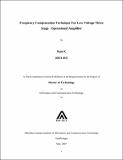Please use this identifier to cite or link to this item:
http://drsr.daiict.ac.in//handle/123456789/163Full metadata record
| DC Field | Value | Language |
|---|---|---|
| dc.contributor.advisor | Parikh, Chetan D. | |
| dc.contributor.author | Kunde, Raju | |
| dc.date.accessioned | 2017-06-10T14:37:14Z | - |
| dc.date.available | 2017-06-10T14:37:14Z | - |
| dc.date.issued | 2007 | |
| dc.identifier.citation | Kunde, Raju (2007). Frequency compensation technique for low voltage three stage operational amplifier. Dhirubhai Ambani Institute of Information and Communication Technology, ix, 54 p. (Acc.No: T00126) | |
| dc.identifier.uri | http://drsr.daiict.ac.in/handle/123456789/163 | - |
| dc.description.abstract | This thesis presents a new frequency compensation technique for low supply voltage three-stage operational amplifier at higher loads. It is based on the miller splitting and pole-zero cancellation using feed-forward path. To reduce the value of compensation capacitance feedback stage is added in series with the compensation capacitance. The amplifier exhibits a dc gain 72db,a gain bandwidth of 35MHz at 63 degree phase margin slew rate 1 v/sμ, a compensation capacitance 4.5pF and load capacitance 300pF while consuming 395Wμat a 1-V supply voltage. | |
| dc.publisher | Dhirubhai Ambani Institute of Information and Communication Technology | |
| dc.subject | Operational amplifiers | |
| dc.subject | Feedback | |
| dc.subject | Electronics | |
| dc.subject | Low voltage integrated circuits | |
| dc.classification.ddc | 621.395 KUN | |
| dc.title | Frequency compensation technique for low voltage three stage operational amplifier | |
| dc.type | Dissertation | |
| dc.degree | M. Tech | |
| dc.student.id | 200511035 | |
| dc.accession.number | T00126 | |
| Appears in Collections: | M Tech Dissertations | |
Files in This Item:
| File | Description | Size | Format | |
|---|---|---|---|---|
| 200511035.pdf Restricted Access | 533.6 kB | Adobe PDF |  View/Open Request a copy |
Items in DSpace are protected by copyright, with all rights reserved, unless otherwise indicated.
